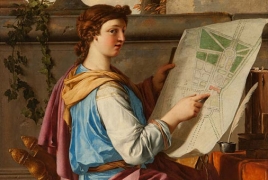“Gardens of the World” major exhibit on view at Museum Rietberg August 15, 2016 - 17:11 AMT PanARMENIAN.Net - Gardens of the World is the first attempt ever to present a comprehensive survey of the gardens of the Orient and the Occident in a single exhibition. Museum Rietberg in Zurich invites visitors to take a stroll through gardens from Japan to England and from Ancient Egypt right up to the present day. Works of art, photos and videos show how people in different cultures and epochs longed for gardens and how they created them, Art Daily said. Is it actually possible to stage an exhibition on the subject of gardens? Albert Lutz, director of Museum Rietberg, was convinced that it was, even before he came up with the concept for Gardens of the World. Yet simply to show the historical development of the garden under a number of headings would surely have fallen short of the mark. Gardens need to be experienced; after all, they are the only art form that appeals to all the senses. “Museum Rietberg is the ideal place for a garden exhibition because it is located in the middle of the magnificent Rieterpark”, says Lutz. The thirty stories of gardens told in the museum’s exhibition rooms begin with paradise worlds. This opening section shows how, both in Europe and in Asia, paradise was usually depicted as an enchanted garden. It includes an installation by the German artist Wolfgang Laib, who has strewn pine pollen to create a radiant field of microscopic yellow dust. It symbolises the quintessence of the garden as the beginning of plant life. This section is followed by a more or less chronological tour: from the gardens of Ancient Egypt to those of Islam, from Japanese and Chinese gardens to European horticulture. Among the more special exhibits is an entire room devoted to the famous insect book by the eighteenth-century Japanese master of woodcuts Kitagawa Utamaro. For Gardens of the World, the two pieces of an Egyptian limestone relief – showing tree goddesses – that are normally housed in two different museums have been reassembled for the first time. The highlight of the Oriental gardens section is a painting on loan from the Louvre that is probably the world’s most beautiful garden painting in Islamic art. The exhibition also features some of the big names of art, such as Claude Monet, Carl Spitzweg, and Max Liebermann. There are garden paintings from Switzerland, too. Works by Paul Klee show how radically his work and his preoccupation with the garden motif changed over the course of his life. Paintings by the Thurgau artist Adolf Dietrich illustrate how one and the same subject – in this case his neighbour’s garden – can repeatedly inspire new works. Contemporary works of art that reference historical gardens are a further focal point of the exhibition. They include copies made by Ai Weiwei of the fountain figures from the garden of Beijing’s summer palace, which no longer exists. Photocollages by David Hockney present some unusual views of what is probably Japan’s most famous garden, the Ryoan-ji stone garden in Kyoto. Roman Signer is also represented, with a video from the garden at Wörlitz, Germany’s oldest landscape garden. Numerous other multimedia installations convey some of the more unusual aspects of gardens. Excerpts from fifteen feature films from the years 1940 to 2011 have been edited together to show a series of garden scenes – of persecution and murder but also of seduction and love. An app created especially for the exhibition turns one of the world’s oldest garden plans, from Ancient Egypt, into a 3D experience. The show continues outside the exhibition rooms. The so-called changing garden right by the entrance – an urban, vertically structured garden – provides a link to the twenty-first century. There is a connection to the exhibition too, as many of the climbing and flowering plants growing on the frames are also depicted in the artworks on display. The Rieterpark, the museum’s villa garden, forms the magnificent backdrop to the exhibition. It is one of Switzerland’s most beautiful landscape gardens and has been planted specially for the exhibition with the kind of flowerbeds that would have been fashionable in the nineteenth century. To allow visitors to admire the garden from an unusual perspective, the loggia of the Villa Wesendonck will be open to the public for the first time ever. The extensive programme of events planned under the auspices of Gardens of the World is also designed to allow visitors to experience gardens in a number of different ways: there will be a market devoted to herbs, a garden festival celebrating life in the great green outdoors and a English-style afternoon tea, bringing a piece of English gardening culture to Zurich. Concerts, talks, garden tours and film evenings will complete the programme. Why did the museum take the bold step of mounting an exhibition on a subject that is so inherently complex and vibrant? “Because it is a great subject”, says Director Albert Lutz, “one that not only appeals to all the senses but touches everybody in some way.” Photo: Sammlung Museum de Fundatie, Zwolle und Heino/Wijhe, Niederlanden The creative crew of the Public TV had chosen 13-year-old Malena as a participant of this year's contest. She called on others to also suspend their accounts over the companies’ failure to tackle hate speech. Penderecki was known for his film scores, including for William Friedkin’s “The Exorcist”, Stanley Kubrick’s “The Shining”. The festival made the news public on March 19, saying that “several options are considered in order to preserve its running” Partner news |